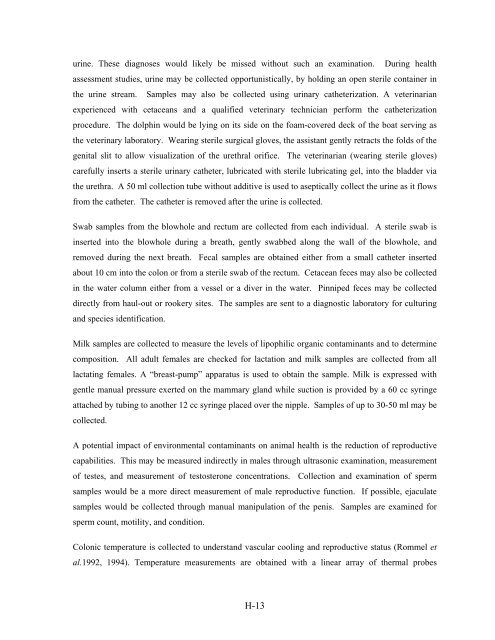Volume III, Appendices EM - National Marine Fisheries Service ...
Volume III, Appendices EM - National Marine Fisheries Service ...
Volume III, Appendices EM - National Marine Fisheries Service ...
Create successful ePaper yourself
Turn your PDF publications into a flip-book with our unique Google optimized e-Paper software.
urine. These diagnoses would likely be missed without such an examination. During health<br />
assessment studies, urine may be collected opportunistically, by holding an open sterile container in<br />
the urine stream. Samples may also be collected using urinary catheterization. A veterinarian<br />
experienced with cetaceans and a qualified veterinary technician perform the catheterization<br />
procedure. The dolphin would be lying on its side on the foam-covered deck of the boat serving as<br />
the veterinary laboratory. Wearing sterile surgical gloves, the assistant gently retracts the folds of the<br />
genital slit to allow visualization of the urethral orifice. The veterinarian (wearing sterile gloves)<br />
carefully inserts a sterile urinary catheter, lubricated with sterile lubricating gel, into the bladder via<br />
the urethra. A 50 ml collection tube without additive is used to aseptically collect the urine as it flows<br />
from the catheter. The catheter is removed after the urine is collected.<br />
Swab samples from the blowhole and rectum are collected from each individual. A sterile swab is<br />
inserted into the blowhole during a breath, gently swabbed along the wall of the blowhole, and<br />
removed during the next breath. Fecal samples are obtained either from a small catheter inserted<br />
about 10 cm into the colon or from a sterile swab of the rectum. Cetacean feces may also be collected<br />
in the water column either from a vessel or a diver in the water. Pinniped feces may be collected<br />
directly from haul-out or rookery sites. The samples are sent to a diagnostic laboratory for culturing<br />
and species identification.<br />
Milk samples are collected to measure the levels of lipophilic organic contaminants and to determine<br />
composition. All adult females are checked for lactation and milk samples are collected from all<br />
lactating females. A “breast-pump” apparatus is used to obtain the sample. Milk is expressed with<br />
gentle manual pressure exerted on the mammary gland while suction is provided by a 60 cc syringe<br />
attached by tubing to another 12 cc syringe placed over the nipple. Samples of up to 30-50 ml may be<br />
collected.<br />
A potential impact of environmental contaminants on animal health is the reduction of reproductive<br />
capabilities. This may be measured indirectly in males through ultrasonic examination, measurement<br />
of testes, and measurement of testosterone concentrations. Collection and examination of sperm<br />
samples would be a more direct measurement of male reproductive function. If possible, ejaculate<br />
samples would be collected through manual manipulation of the penis. Samples are examined for<br />
sperm count, motility, and condition.<br />
Colonic temperature is collected to understand vascular cooling and reproductive status (Rommel et<br />
al.1992, 1994). Temperature measurements are obtained with a linear array of thermal probes<br />
H-13
















